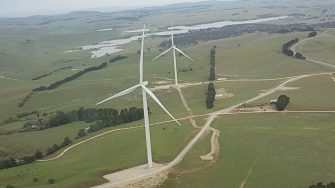
Date: Wednesday, October 17, 2018
Project: Eastern Australian Waterbird Survey
Observer: John Porter
Steady rain overnight in Griffith is extremely welcome for the locals but not so helpful for low level aerial survey work. We fuel up and head out to Tuckerbill and Fivebough Swamps near the town of Leeton. Tuckerbill is about 50% full and has low numbers of waterbirds. Fivebough has low water, about 20% full and a few hundred ducks and shorebirds – Glossy ibis, Mountain duck and Australasian shoveler are in the mix of birds today.
Low cloud east of Griffith.
South east of Leeton Lake Coolah as dry as expected but the adjacent wetland Mejum Swamp has water and we find black duck, yellow billed spoonbill and black swans in residence. This wetland has a dense cover of red gum so we have to work hard to spot the birds through their canopies.
Tools of the trade - topographic map and digital voice recorder.
Most of the remainder of the day covers canola and wheat growing areas so there are only a few scattered dams and ground tanks to count – many of them dry and most with relatively few waterbirds. Fields of wind turbines producing free energy from the wind have sprung up like mushrooms near Crookwell and we work our way through to count Pijar dam which has only low numbers of waterbirds.
Wind turbines and Pijar Dam near Crookwell, NSW.
Wingecarribee swamp (once home to several endangered species of tiny Gentian lillies before peat mining damaged the wetland) has few waterbirds and we finish the day over Fitzroy Falls Reservoir (again with few waterbirds) before heading back to Sydney.
